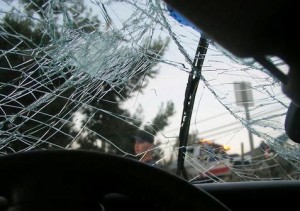
Though it agrees distracted driving is a major problem, a key insurance industry group questions the need for a blanket ban on all in-car technologies.
Not everyone believes that a wholesale ban on using cellphones – along with other electronic devices – would make driving safer.
In fact, existing laws that already restrict the use of handheld phones have had no impact on reducing distracted driving crashes, according to the Insurance Institute for Highway Safety, which questions the value of a recent proposal by the National Transportation Safety Board to take existing laws to a new level. After studying a series of major incidents linked to distracted driving, the NTSB this month recommended sweeping new rules that would effectively bar drivers from using most electronic devices.
But speaking with CNN, Russ Rader, a spokesman for the IIHS, cautioned that “distracted driving is much bigger than just phones,” adding that, “”focusing on phones doesn’t deal with the full spectrum of things that distract.”
Currently, talking on a handheld telephone while behind the wheel is banned in 10 states, including California, New York and New Jersey, as well as the District of Columbia. There are numerous towns and cities that also ban the practice in states that have not taken action. Meanwhile, 35 states have banned texting – with another barring novice drivers from texting.
(For a more detailed list, Click Here.)
While there has clearly been a reduction in the number of drivers using cellphones, according to IIHS data, the organization last year released a study showing no measurable reduction in crash rates in key states that initiated bans, including California, Connecticut and Washington, D.C.
So, even though the insurance industry trade group proclaimed, the “crash risk is four times greater” while using a handheld phone, it concluded, “collision claim frequency has been unaffected by state bans on handheld phone usage by drivers.”
The lack of support by the IIHS could make it difficult for the NTSB to sell what many observers have labeled a “draconian” ban on the use of virtually all electronic technologies in the vehicle, including hands-free phones and other devices. Since the Transportation Safety Board does not have the power to regulate it would have to win over lawmakers in Washington at a very politically charged time when there is strong opposition to new government rules and regulations.
Nonetheless, there are also those who strongly support the proposals, including Ray LaHood, head of the U.S. Dept. of Transportation, who has called distracted driving a “national epidemic.”
Earlier this month, the DoT’s National Highway Traffic Safety Administration released new data showing U.S. highway deaths had fallen to an all-time low when measured by fatalities per 100 million miles driven. But the NHTSA also noted about one in 11 deaths, over 3,000 in total, were the result of distracted driving.
Automakers are expected to provide strong resistance to any outright ban on the use of new technologies. They insist their latest – and highly profitable – new hands-free systems, such as Ford’s Sync and Cadillac’s Cue, can significantly reduce the problem of distracted driving.
Ford’s in-house studies indicate that the real problem occurs when drivers take their eyes off the road for more than a couple seconds at a time – which is why the maker and others are emphasizing new voice-control technologies.
They’re also adding new systems designed to compensate when a driver is distracted – for whatever reason. Ford, for example, just introduced a new system designed to alert a driver drifting out of their land, even gently helping steering the vehicle back on course. And it can flag a motorist who might become drowsy.
How much such technologies can help – in particular by reducing the dangers of distracted driving – remain to be seen, though a recent IIHS report broadly praised a new system introduced by Volvo that can help stop a vehicle automatically in low-speed traffic if the driver is distracted.
The flip side, warned spokesman Rader, is that drivers could grow too dependent upon such technologies and allow themselves to become even more distracted by cellphones and other in-car devices.
